Festivals
London Film Festival 2010:
The Sight & Sound blog
Week two »
Off the rails: Jamie Thraves’ Treacle Jr.
and Peter Mullan’s Neds

Aidan Gillen in Treacle Jr.
Nick Bradshaw, 24 October
“In Britain,” wrote Jonathan Romney in our LFF-special November issue, “new filmmakers may get the chance to prove they can direct. But very few find the opportunity to show they might have the makings of an auteur – that is, to display a consistency of thought and style to be explored in depth over several films.”
Romney was celebrating the seeming exception of Joanna Hogg – although, talking at the festival filmmakers’ tea on Saturday, she says the gap between her slow-born debut Unrelated and the new Archipelago was in fact longer than the three years’ difference in the registration dates. Still, other British talents go missing for much longer, and not because they want to be Terrence Malick. I caught up with a couple in the festival which we’d not managed to see in time to preview in the aforementioned ‘British Invention’ special issue.
Peter Mullan’s Neds is his first directorial feature since 2002’s scathing Venice-winner The Magdalene Sisters. Jamie Thraves finally followed up his sparkling 2000 debut The Low Down with last year’s comprehensively neglected Patricia Highsmith adaptation The Cry of the Owl, a brooding and frequently fascinating genre experiment starring Paddy Considine and Julia Stiles that perhaps wanted for a little more assurance or fluency. He’s managed the faster turnaround on his self-produced third film, Treacle Jr., by remortgaging his house, pulling in favours and hiring his cast and crew on deferred fees: the sort of no-budget recourse that used to be recommended as a career launchpad, but may be increasingly be the future of auteurist filmmaking, at least if producers can find a way to make it pay.
Both films turned up in London fresh with prizes from abroad, Neds having won the Golden Shell at San Sebastian, while Treacle Jr. shared the Golden Hitchcock with Made in Dagenham at the Dinard British Film Festival. And both probe the inner turmoil of shuttered characters as they careen dramatically off the straight and narrow.

I got a wife and kids in Baltimore, Jack
I went out for a ride and I never went back…
— Bruce Springsteen, Hungry Heart
Treacle Jr. starts with Tom (Graham Chapman ringer Tom Fisher) setting out like on any other commuting day, kissing his wife and childhood goodbye and driving from his semi-detached home to the train station (Birmingham New Street). Getting off at Euston, he finds a quiet pavement corner and flops down on the street; later flirts with the notion of binning his wallet and family photo therein; and come nightfall is forced to flee a gang of gay-bashers by running into the only tree in the park.
Which brings him the next day to A&E and the attentions of Aidan (Aidan Gillen), a happy-go-lucky, voluble extrovert who wears a button-covered blazer and baseball cap and lisps like an Irish Donald Duck. (“You know what I’d just love right now? A hot bitch. The sun, the sky…”) Tom himself may want to be an island at this point, but of course Aidan sticks to him, offering him shelter and prattling company until Tom starts to thaw.
Gillan’s outré turn (offering door-to-door hedge-cutting services with a pair of scissors, one-downing The White Stripes at a drum kit et al), a restrained whimsicality and and a slow-burn consideration of Tom’s unease all put some meat on the story’s bones. What also enriched things was the presence of Aiden’s live-in non-lover Linda (Riann Steele), a soot-hearted bully as troubled as any of them (in fact she probably warranted more exploring), who knocks Aidan around but can’t quite knock him down.
She helps pull the film away from the familiar redemptive odd-couple refrains of The Fisher King et al, and shifts the personal and sociological balance towards she and Aidan’s London world. Thraves describes Aidan the most optimistic character he could imagine – he comes up giggling when Linda hits him – and the film, notwithstanding a couple of cute movie-ish moments, is another incisive portrait of unexpected encounters and individual power dynamics to sit with Thraves’ previous films.
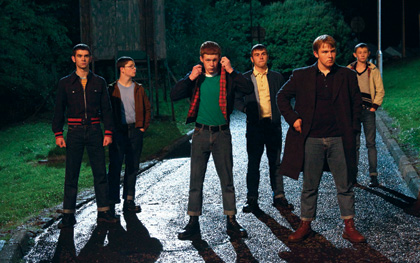
Conor McCarron (second from right) in Neds
Neds is madder. For a long time it looks like being a similar tale of personal fall and recovery, not to mention the best slice of 1970s Glaswegian council-estate realism since Ratcatcher (1999), and before that Gillies Mackinnon’s Small Faces (1995): it follows young blue-collar A-student John McGill (Gregg Forrest, and later Conor McCarron), whose elder brother’s gang infamy precedes John, as he spurns his academic promise for the greater satisfactions of fighting, teacher-baiting, and wreaking vengeance on his drunken father (Mullan himself) and rival gang members alike.
The closed and petty viciousness of the school system, teen culture, right-side-of-the-tracks families, sink-estate architecture and just about every male role model in this exceptionally masculine film are all scrupulously charted. Even then, John himself is a untameable force of nature, progressively terrifying even his newfound gang pals with his extreme fearlessness, will to revolt and ready recourse to violence. (Mullan denies that the film is precisely autobiographical, but the alienation of being an over-achiever in a culture of low expectations is clearly an experience he knows.)
As in both Ratcatcher and Mullan’s earlier films, there are surreal flights of fantasy: a down-for-it Jesus, a Glaswegian lion pack. And like John himself, the film seems quite untamed – it just keeps going. Which in this milieu may be the most optimistic thing you could imagine.
Sight & Sound special screening:
Uncle Boonmee Who Can Remember His Past Lives
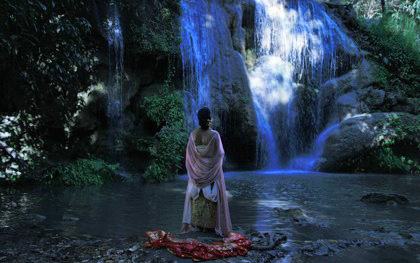
Kieron Corless, 18 October
If last year’s big LFF buzz-film was Dogtooth, this year’s has to be the Palme d’Or winner from Thailand, Uncle Boonmee Who Can Recall His Past Lives, directed by Apichatpong ‘Joe’ Weerasethakul, which this magazine was thrilled to have as its gala screening on Sunday night.
Expectations were astronomically high: Apichatpong has raised the bar himself with his previous three features, all phenomenal in their own particular ways, plus an array of gallery-based work and shorts, becoming in the process a talismanic figure for a certain kind of contemplative, exploratory, expanded cinema. But as I joined the excited throng at the Vue in Leicester Square, I’d be lying if I said I didn’t feel some apprehension that Uncle Boonmee would fail to live up to the hype a Cannes winner inevitably generates.
For some strange reason the LFF ad played twice before the film started. Was this a deliberate attempt to unsettle us and put us in the right ‘zone’? Or a nod to Joe’s penchant for bifurcated structures (which incidentally he seems to have abandoned here)? Joe himself introduced the film, drawing attention to its hybrid nature: some people view it as sci-fi, others horror. Just recently it played at a festival of fantastic cinema. Still others find it comical (it does have one killer line early on). But most of all Joe urged us to abandon any attachment to logic or preconceptions about what a film narrative should be, which proved sound advice indeed.
And so it began. Pretty soon it became apparent that this was something special. You can always tell when an audience is in thrall, spellbound; there’s a palpable quality of attention, a sense of total collective immersion.
Uncle Boonmee basically breaks down into a series of 20-minute segments, all quite different stylistically; but it’s the way Joe makes the transitions between them feel so seamless that, as much as anything, marks him out as a miraculous editor. Many people were bowled over by the scene in which a disfigured princess is firstly conversed with and then pleasured by a catfish, and for sure it’s like nothing you’ll ever have seen before. But the sequence where the dying Boonmee recounts a dystopian dream over a series of still photos of young boys in military uniform completely froze my blood.
We’ve put Apichatpong on the cover of the December issue of Sight & Sound (out 2 November) under the moniker ‘Extraordinary Joe’, and that feels completely apposite; right now he has to be one of the most groundbreaking directors at work anywhere in the world.
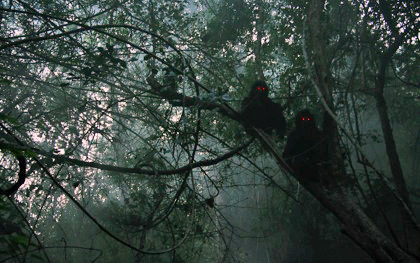
The Q&A, led by S&S editor Nick James, was fascinating. Joe proved to be cool, clever, diffident, the epitome of courtesy and geniality. Unfortunately I was still stranded somewhere in Apichatpong-land, and kept getting distracted by what was happening to the left of the auditorium, where the heads of producers Simon Field and Keith Griffiths and various New Wave distribution staff were just discernible over a side wall, bobbing about and peering at proceedings. I kept imagining their heads adorned with striking, ominous red eyes, just like the strange monkey-like creatures in the film (above). Now that really would have been a Q&A to remember.
The final scene in the film sees two characters splitting into two separate selves – one pair watching TV, the other heading out for dinner. It’s a genius idea, not least because it suggests one way of coping with the plethora of fine films at this year’s LFF, which is turning out to be the best in my memory. Discussion of this final scene towards the end of the Q&A started to veer into the realm of quantum physics; unsurprisingly, our editor chose to wrap proceedings right there, with what looked like an expression of relief on his face.
The mood at the reception afterwards was jubilant and celebratory. I heard nothing but out-and-out praise for the film, not a single reservation; that sort of critical unanimity is very rare in my experience. It should be noted that Uncle Boonmee is co-produced by a British company, Illuminations; hearty congratulations are due to Field and Griffiths, two of the most courageous and imaginative producers in the business. It’s a very strong British line-up at this year’s LFF – the new films by John Akomfrah, Clio Barnard and Patrick Keiller are especially outstanding – but winning the Palme d’Or with Apichatpong has to be the pinnacle of British filmmaking achievement in 2010.
As chance would have it, I found myself face-to-face with Apichatpong at 9.30am next morning, for our Sight & Sound interview. Joe had a heavy cold, but was still as warm, generous and incisive as ever. You’ll find that interview in the December issue, alongside a brilliant piece on Apichatpong’s career to date by Adrian Martin.
A quick chat before the interview with the publicist turned to the subject of the film’s prospects in the UK market (possibly damaged, in my opinion, by an incredibly lazy and ill-judged article that appeared on the Guardian’s film website recently about Uncle Boonmee’s supposedly poor reception in France – a curious postscript to Peter Bradshaw’s five-star review). These are difficult times for the smaller distributors trying to release adventurous subtitled films in Britain, but more than any other I can think of, Uncle Boonmee deserves to break out of the ‘arthouse’ ghetto to a wider audience, and give its excellent distributors New Wave a much-deserved minor hit. It opens on 19 November; go, and be astonished.
Errol Morris’s Tabloid

Isabel Stevens, 17 October
The story goes that Errol Morris’s wife once went to collect some books for her husband. Unable to find the reserved items, the assistant in the bookshop asked her if she knew the names of the titles. No, she said, but I know the subjects: “they’re probably about insanity, murder or Nazis”.
In his documentaries Morris has tackled such heavy subjects as the Texas justice system and the Vietnam War. His last film took on the US military over the torture photographs from Abu Ghraib. In comparison, his latest offering looks like it was rather fun to make, and it’s undoubtedly his most entertaining film to date: Tabloid is a portrait of Joyce McKinney, a former Miss Wyoming who in 1977 set the British media on fire when she allegedly abducted a Mormon man and forced him to have sex against his will.
“It’s a fairytale. As such it’s very perverse and demented,” was producer Mark Lipson’s introduction to the screening on Saturday night. (Morris was sadly absent.) Certainly, I challenge you to find another film this year that will raise your eyebrows so frequently over 87 minutes; it’s surprising even to those familiar with the tale of ‘the manacled Mormon’.
Tabloid is visually jazzier than Morris’s previous works – in addition to animated sequences and fiction-film clips, tabloid headlines flash intermittently across the screen. And who would have thought a Morris film could be so funny? Instead of the odd moments of the dark humour we have become accustomed to, Tabloid periodically had the audiences in stitches, no small thanks to McKinney herself, a very chatty, charismatic interviewee.
Yet underneath the tales of temple garments, chains and beauty queens lies Morris’ true subject: the slipperiness of the truth. As he investigates the tabloid furore that ignited around McKinney (one which she was initially more than happy to fuel), testimony and fantasy become inextricable. As a then-Daily Express reporter notes, “the truth is somewhere in between.”
Morris calls the film “a love story”; no doubt some will beg to differ. But to his credit, everyone will walk out of this film with their own interpretation of the truth. And unlike a good number of documentary makers, Morris is not out to hang his subject. We might be suspicious of McKinney’s version of events, but it’s impossible not to be a little bit seduced by her too.
“She seems like a woman who could be your best friend when she liked you and your worst enemy when she didn’t,” commented one member of the audience, going on to ask what everyone wanted to know: what was Joyce’s reaction to the completed film?
Lipson’s pithy response: “Your question was the summation of the situation.”
Correction (25 October 2010): This post originally referred to the producer attending the Q&A as Robert Fernandez, who executive-produced the film. The actual producer in question was Mark Lipson. This has been corrected above.
Pandora’s Box, restored
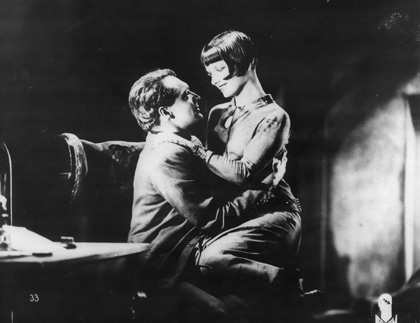
James Bell, 15 October
To the BFI Southbank last night for the first screening in this year’s archive selection: a new digital restoration of GW Pabst’s silent 1929 masterpiece Pandora’s Box, boasting, of course, Louise Brooks’ stupendous, iconic performance as Lulu, who is “practised in the art of flattery” and beguiles everyone she meets (even attorneys prosecuting her), yet comes to a tragic end. As the festival’s Treasures from the Archives strand’s programmer Clyde Jeavons reminded us in his opening remarks, the film wasn’t a success on its first release in Berlin in 1929, and it was only after it was revived by the likes of Henri Langlois in the 1950s that it secured its reputation as one of the most intoxicating and erotic of all silent films, and prompted Brooks herself out of obscure retirement to write Lulu in Hollywood, her great memoir of the silent years.
The many years of neglect had taken their toll on the film: no negative or original print survived, only inferior dupes ridden with scratches and other damage, out-of-focus sections, and missing intertitles that made many passages of the film confusing to follow. The new restoration was overseen by the Deutsche Kinemathek’s Martin Koerber, and was a great advertisement for what can be achieved through new digital techniques. It’s been said many times before that watching Brooks is like seeing a woman of today step into a bygone world, so modern is her poise and charisma, and that impression is only more enhanced by the pristine new picture. Her performance anticipates so much of the cinema acting that would follow; it is still astonishing how naturalistic she is, while at the same time unreachably star-like.
The film was accompanied brilliantly on the piano by Neil Brand, and I caught him afterwards – looking rather exhausted after an unbroken performance over the film’s 143 minute running time – for a few words:
“It was the second film I ever accompanied when I started out – so over the past 28 years I assume I’ve now played it 25 or 30 times. Initially what really hit me was Louise Brooks, and I think I just tried to play her. The little sparkly theme that I use, which is trying to be the sound of the kind of effect she has on people, I wrote for the very first performance I did. It sometimes gets a laugh, because as she lights up for the next man who comes into view the audience thinks, “Ah, she’s already got him!”
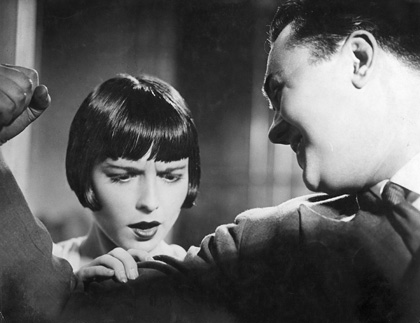
“Over the years two things have struck me above all about the film: one, that it really does bear this amount of attention – I have yet to get bored with it – and I’m sure that’s because it’s made with such an innate attention to detail, and a wonderfully complex view of morality. I know there are people who don’t buy this, but it’s trying to have it both ways: it’s saying that she is Pandora, she does have the power to seduce men and break them, but she is also herself a victim. At no time is any judgement made on her or on any of the other people in the film. It’s an entirely unjudgemental film, extraordinarily emotionally mature.
“Each time I play it new insights crack open. Tonight, just like everyone, I was firstly so amazed by how beautiful it was, and then I noticed that the first character we meet – the concierge, one assumes, for Lulu’s flat – never reappears after he’s introduced her. I spent the next two minutes wondering, “Why did Pabst choose to introduce Lulu with a character we’re never going to see again?” And it’s because he needs to lead us in with a character who is ‘us’ – a character completely enamoured but also slightly bemused by her behaviour – because otherwise we’d be asked right from the start to accept something that we might not want to accept. I think that’s just beautifully clever.
“There are so many such moments; I don’t remember the horrible sequence in which they get the lesbian Countess Geschwitz to seduce the fat strongman ever being so well delineated. Another thing that’s grown on me over the years, and therefore where the music has changed, is how entirely honourable a character Geschwitz is. I just feel utterly sorry for her; she’s completely manipulated by Lulu. If Lulu is guilty of nothing else, it’s of the destruction of a woman who does nothing but love and support her throughout the film. That comes across incredibly clearly now.
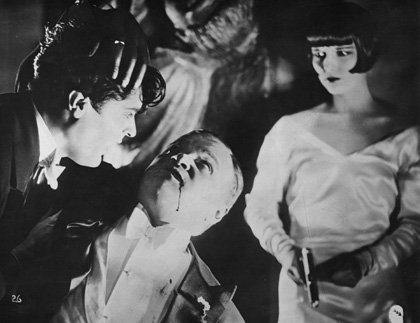
“When I first started playing this film I always thought the jumps across its storyline, and the slight sense of drifting from one character to the next, were slightly awkward, and the music had to try and compensate. With the new print and intertitles, which divide it into six acts, all those rough edges are smoothed out and the story is framed so much better.
“I totally respond to the film in the moment. I do come with two or three themes that I know will work, including the sparkly one. For the Christmas scene, which is magical and comes up fresh each time, I’ve always used that combination of ‘The Coventry Carol’ and ‘God Rest Ye Merry Gentlemen’ as an ironic take on Christmas. Christmas is slightly Dickensian in the film: she’s literally freezing in a garret while people are eating Christmas pudding around her. I’ve always found people really respond to tunes they know around that scene.”
The restoration is projected at 19 frames per second, slightly slower than the film used to be shown. How does that change how you approach it musically?
“I have to say I find 19 fps slightly too slow for my own taste. Some moments are spot on, but some feel slightly elongated. Twenty would be my preferred speed for the whole thing; but it does give me the chance to open the music out, and I get longer to complete my themes and fill things in with experimental stuff. I still experiment each time I play it, because I’m still trying to find that mythical, perfect score, and it ain’t there yet! I never will find it, of course, but the beauty is that each time there may be just one scene that I hit right on the nose in that performance, and I pride myself on that.”
Opening night: Never Let Me Go
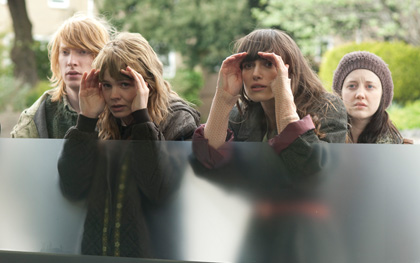
Nick James, 14 October
The morning of the festival’s opening kicks off for me with a junket interview with Kazuo Ishiguro, whose novel Never Let Me Go has been adapted for the screen and is the opening night film. He’s in a fine mood. The question came: can books which require you to read between the lines, like his, be made too explicit by cinema? He counters with the suggestion that actors, by saying one thing while their bodies tell you another, can enrich characters in a way that fiction can’t.
Onstage at the Odeon Leicester Square that evening, Ishiguro extends the notion by hailing the young cast of the film – Carey Mulligan, Keira Knightley and Andrew Garfield – as a brilliant new generation of British actors with a style of their own. The film is unquestionably a mournful choice for opening night – it is, after all, about how brief a candle existence is – and while I was affected by it when I saw it at a press screening a week ago, this second viewing leaves me dry-eyed, and thinking that Rachel Portman’s string score has to work too hard to fill in for the many scenes of wordless gazing.
The screening is delayed by the insatiable needs of the bank of photographers on the red carpet to gather thousands of near-identical shots of Carey and Keira. Thus the party at the Saatchi gallery in Chelsea is a swift affair. I talk to Joanna Hogg, director of Archipelago, congratulating her on how very funny her tortuous upper-middle-class family-holiday drama is, encouraging her to take this talent for very dry class humour further. I suggest she looks at some of Samuel Beckett’s most drop-dead passages. She mentions Terence Rattigan as a recent influence but Terence Davies has got there first – he is in pre-production for Rattigan’s The Deep Blue Sea, which, as it happens, will feature fast-rising star Tom Hiddleston, the lead in Archipelago.
Joanna introduces me to Hiddleston and I tease him about the “gap year yah” nature of his Archipelago role. He kills my flippancy by telling me he went to a real interview for a job working with AIDs sufferers in Africa, as his character intends to, and they surprised him by telling him that, if he took the job, he’d be allowed no contact with the outside world for three months. That detail ended up in the film.
The rest of the party is all quick meet and greet. This year’s LFF, then, already feels like it’s all about cramming as much as possible into your time.
Week two »
See also
London Film Festival 2010: 30 recommendations (online, October 2010)
p>Reasons to be cheerful: Ryan Gilbey celebrates a crop of bad-mannered new British films (October 2002)Ratcatcher reviewed by Charlotte O’Sullivan (November 1999)
Orphans reviewed by Edward Lawrenson (May 1999)
Sight & Sound’s best online videos of 2009 led by Phantoms of Nabua (online, January 2010)
Tropical rocket: Tony Rayns on Weerasethakul’s ‘Primitive’ exhibition at Liverpool’s Abandon Normal Devices festival (online, October 2009)
Documentary: shaking the world: Mark Cousins wonders whether documentaries can change history (September 2007)
Warmonger blues: J Hobermann on Errol Morris’s The Fog of War (April 2004)
In the magic hour: 3 silent classics by Josef von Sternberg reviewed by Michael Atkinson (October 2010)
‘Underground’, overground: Nick Bradshaw and James Bell on two archive showcases of London transport in the 2009 London Film Festival (online, October 2009)
Innocence reviewed by Jonathan Romney (November 2004)
